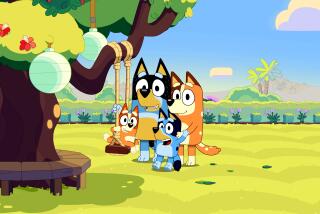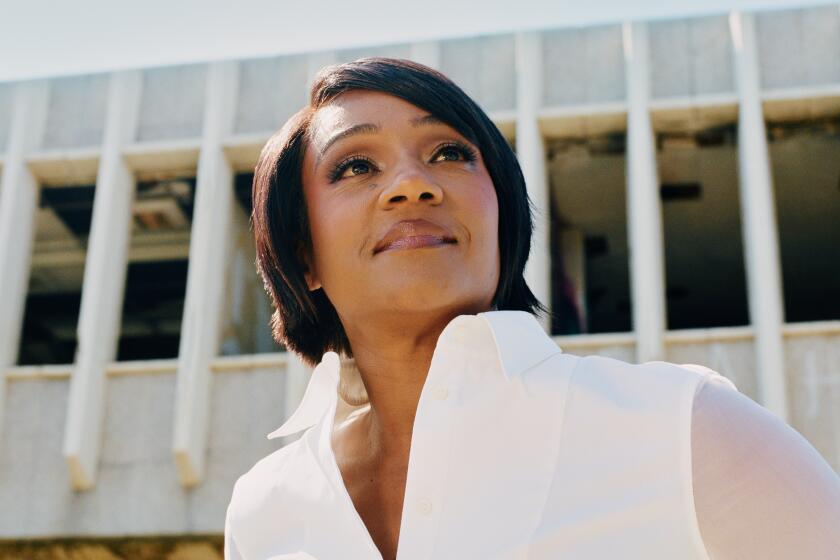‘Once Upon a Time’ effects are part of a legacy for Orloff, Zoic Studios
“Once Upon a Time” has already had Elsa’s numbing cold powers, a giant snow monster named Marshmellow and a troll named Grandpabbie as part of its more notable CGI offerings this season. In its fourth go-round, the show uses an array of special effects and green screen shots to make the fantasy worlds of the fairy tale show come to life. And visual effects supervisor Andrew Orloff, along with Zoic Studios, are leading the whimsical charge.
The company has created the visual look and feel for a number of popular shows, including “Buffy the Vampire Slayer,” “Firefly” and “Battlestar Galactica,” on which the locations -- a Hellmouth in Sunnydale, a lone ship in the ‘verse, a ragtag fleet of human survivors -- were often central to the storylines. We caught up with Orloff to talk a bit about the worlds, plural, represented in “Once Upon a Time” and the logistics involved.
How did Zoic Studios come about?
The studio was started by myself, Loni Peristere, Chris Jones and Tim McBride in 2002. So, we’re at 12 years. We were visual effects artists -- Chris and I were effects artists and Loni was a visual effect supervisor and Tim was from the business side. We decided to launch out and do our own thing instead of being attached to someone else’s company. We wanted to focus on features and commercials, but also really service our television clients because we saw television as something that was really growing at that time. As “Firefly” was coming into its first season, we were really in what I think of as a revolution in television content in terms of visual effects. We started with “Buffy,” “Angel,” “Firefly,” and worked with some of the other big franchises, “CSI,” “Fringe,” “Pan Am,” “True Blood,” “Battlestar Galactica” ... and we’ve been working on “Once Upon a Time” since the very beginning. We work on a lot of cool shows, and the common thread is that they all have a unique visual style.
And with “Once Upon a Time,” there’s a definite visual style. But even within that, there’s so many worlds to create when you have Oz and Neverland and more. What are the challenges of doing this particular show?
It’s a lot of fun to work on a show like this. It’s just flat-out awesome to be able to have conversations like ‘What is this ogre gonna look like?’ and ‘What is this dragon going to look like?’ and ‘How are we going to make this fairy creature look different from the last fairy creature that we did?’ The show has already built its own mythology, so it’s even more fun to go back into the history or library of that. But, it’s also one of the challenges that we have. Like you said, we have all of these worlds like Neverland and Arendelle and the deck of a pirate ship that’s shot on green screen, Frankenstein’s lair and the fairies’ cloud city. Land, sea, air, environments on fire ... we wanted to do it all. But in working with the people like the directors ... just standing there saying ‘Imagine if you will the most opulent cathedral ever for the marriage of Snow White and Prince Charming’ -- well, it doesn’t really work that way. One of the biggest challenges and successes that we’ve had on the show is working with the art department and the creators of the show on a system to design these environments to implement them and get everybody creatively ‘bought in’ along the way.
So we developed a proprietary system that we call Z.E.U.S. -- Zoic Environmental Unification System. We have an iPad application that lets them walk through the virtual set before we even get to the green screen stage. We work with a company called Lightcraft to give us real time feedback, which means when we see the cameras, we have a special system that takes basically a video game engine and uses that, rendering it out in real time based on what the camera is doing, and puts a temporary composite of the environment together. We can see it, we can perform to it, we can light it, and performers can go in and out of doors. That kind of stuff, and bringing that kind of virtual environment to the real world has been one of the biggest challenges.
Do you have a lot of editorial say?
We consult and collaborate on every part of the process. We get to be part of every part of the filmmaking process from the outline of the scripts to the final delivery. Many of the scenes, they don’t have what they need to edit the show properly, so we become the production department. We’re in a good rhythm in Season 4 and we have a good working relationship with the creators, Adam [Horowitz] and Eddie [Kitsis]. They trust us so completely that they keep upping the ante. [But] sometimes I look at these scripts and go ‘Oh my God, how are we going to do this?’
On “Buffy,” ’dusting’ the vampires seemed to be a signature effect. The teleportation smoke seems to be one on “Once...”
We do a lot of different magic and we have a lot of different spells that we’ve created. One of the main things we do is what we call smoke poofs, or teleportation smoke, where the character gets enveloped in smoke and the smoke dissipates and either they’re gone from that location or have been transformed in some way.
Like we were able to do on “Buffy” with the dusting effect, we started at the pilot. One of the great things about it being a TV show is that we have multiple episodes. We’re going to be at close to 100 episodes by the end of the season, and each one of them may have that same effect in it. We’ve changed the methodology and the software used for it. One of the things that you can do on a TV show and not on a feature is come back to an effect and say ‘How can we do it better?’ ‘What are the software advancements that can make it be more realistic and more detailed?’ So, we’ve been evolving that effect show by show, season by season since we started.
When we did “Buffy,” it was a different type of visual effect environment. We’d do a bunch of shots, then have to stop the camera, the visual effects happened, then we continued the scene. We did the best that we could within that. Once we got more advanced, we able to add real life camera moves, and that was a big part of “Battlestar Galactica” and “Firefly.”
Are there any “Once” effects coming up that you are particularly looking forward to?
There’s a lot of cool stuff coming up, though I am forbidden to say under 10 different NDAs [or Non Disclosure Agreements]. But I will say that the pilot is just a taste of what’s coming. The last three seasons, we’ve really explored what Storybrooke and fairy tale land is all about. We visited Oz and we visited Neverland, but this season more than any other, there’s new places to explore, new characters to meet. ... Everything is new. And it’s really a cool opportunity for Zoic because it’s like starting the show over again, but knowing what worked and didn’t work in the past.
Do you have a favorite visual effect?
That’s one of those ‘Which of your kids do you like better?’ questions. As far as the premiere, I was really excited about the stormy seas stuff. We work with a company called Fusion. We partnered with them because they’re experts in doing water simulations, and water simulation is something you normally don’t see on television because it’s too expensive and too time-consuming. We were able to get that done, and I think it drags everybody in to the danger and the jeopardy of the story. I think it works well, and it was really fun.
Twitter: @Storiz
More to Read
The complete guide to home viewing
Get Screen Gab for everything about the TV shows and streaming movies everyone’s talking about.
You may occasionally receive promotional content from the Los Angeles Times.







